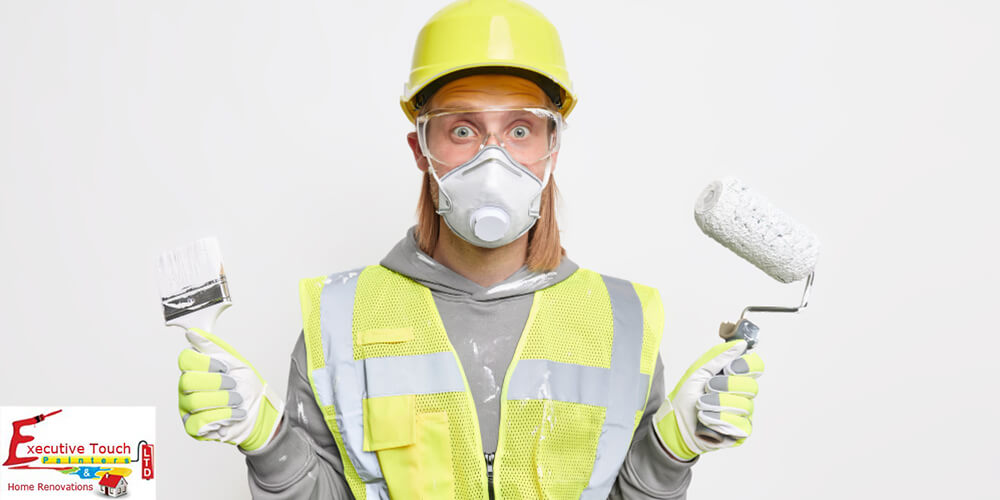
The safety of painters during home, business and construction painting is a must. They constantly face hazardous situations that can cause a threat to their lives, such as working at heights, working with various chemicals and solvents, and working on ladders in a very confined space. These are the most common threats that can be taken care of for a productive and safe workday. Now let us know the types of hazards and the Safety measures in commercial painting one can follow.
Six types of hazards can be harmful. These hazards are listed below.
Safety hazards cause immediate accidents and injury. Broken ladders, slippery floors and hot surfaces can cause this. The results can be broken bones, cuts, shock, burns and sometimes death.
Physical hazards can be environmental factors that can harm without touching the body. Physical hazards can be caused by radiation, high exposure to ultraviolet rays, loud noise and extreme temperature.
Chemical hazards can be caused when a worker is exposed directly to chemical preparation in the workplace. The chemical can be in any form, solid, liquid or gas. The chemicals include cleansing products, asbestos and pesticides. Some chemicals are safer, but some workers who are sensitive to chemicals can cause illness, skin irritation, red eyes, and breathing problems.
Biological hazards are associated with animals, Infectious plants, or people. This includes bacteria, viruses, animal droppings, plants, body fluids and more. People working in hospitals, laboratories, nursing homes, colleges and universities, schools and outdoor occupations are more prone to Biological hazards.
Ergonomic hazards occur when work conditions strain a person’s body. The strain may be caused due to work, body position and work conditions. These may not be visible immediately but can cause sore muscles quickly. But it can cause serious illness in the long term. Ergonomic hazards can be caused due to poor posture, awkward moments, using too much force and repeating the same movements repeatedly.
Work organization hazards caused due to excess stress during short-term effects and strain during long-term effects. These can be caused due to workplace issues related to workload, lack of control, etc. Some examples of work organization hazards include intensity, workload demand, sexual harassment, etc.
Having the right types of equipment while working can help you avoid hazards. Some of the safety equipment for painters are mentioned below.
Protecting eyes from splash, paint and paint thinners is the most important precaution every commercial painter should follow. Eye goggles and face shields are important during painting above your head, spray painting and sanding.
Always wear gloves to protect your hands from harmful chemicals. Different gloves are used for different types of tasks. For example, leather or cotton gloves are best for use during the sanding process. Waterproof gloves are best for water and oil-based paintings.
Masks and respirators come in handy during protection from dust and fumes. Use a dust mask/respirator while sanding paint respirator while spray painting to protect you from harmful chemicals and dust. Each mask and respirator has specific users based on the task performed.
Using a coverall for your body and disposable shoe covers are handy while painting. They cover your shoes and clothes, so you are not exposed to hot or cold weather. So having an extra layer of thin cloth helps to protect you from direct contact with radiation caused by the sun or extremely cold temperatures.
Painting jobs usually are done at a high level. So, avoiding makeshift ladders and inspecting the ladders is required every day. Also, make sure the ground on which the ladder is placed is clear of clutter and no more unnecessary equipment is lying around.
Avoid using sodium fluoride, mercury compounds or phenol in water-based solutions. While handling ammonia, always use gloves, goggles and an apron. Always open the window using acrylics to avoid eye, nose, and throat irritation.
While using non-water-based paints, always wear neoprene gloves for cleaning brushes with turpentine. The non-water-based paints can be removed from hands using baby oil, soap, and then washing hands with water. Never heat paint with an open flame or hot plate, exposing the element.
Always try to brush rather than using spray guns, airbrushes, and spray cans. If used, then make sure to avoid solvent-based paints and choose water-based airbrush paints. Avoid spray painting from the mouth through the tube. This can lead to inhalation/ingestion of paint.
Painters’ health and safety measures play a vital role in commercial painting. Working surrounded by hazards can affect their physical and mental health. So maintaining a proper safety measure and providing them with the right equipment during the painting is necessary. Executive Touch Painters Ltd has proficiency in residential and commercial painting services. Our workers are highly skilled and provide the best output. Book a free estimation, or contact us at (416) 410 – 0164.